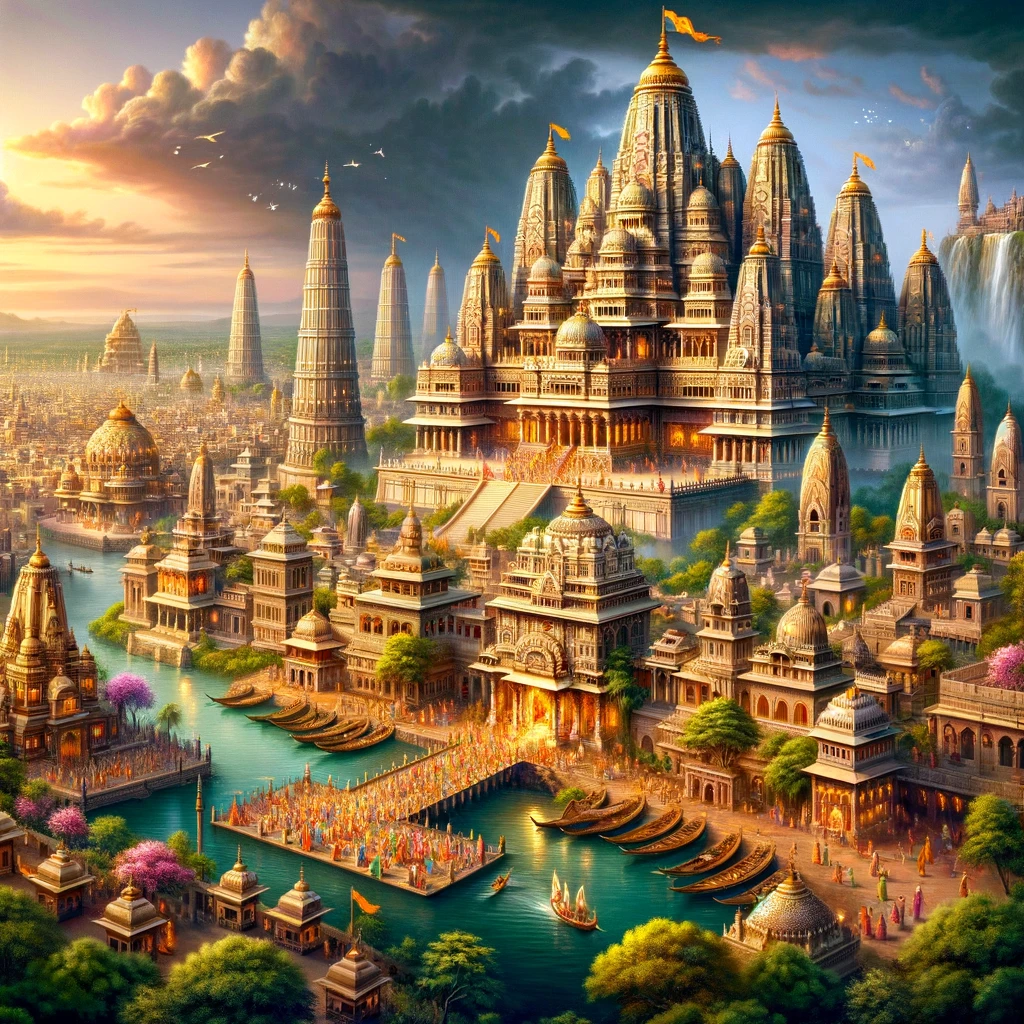Summary
We enter the capital of the Emperor Dasharatha. The pomp and glory of his capital is depicted [described] along with its town planning and grandeur [magnificence] of the city, and its residents.
Chapter [Sarga] 5 in Detail
Once upon a time, under which victorious kings, this entire earth with all its islands is there, starting from Prajapati; among which kings there is one named Sagara, who deepened [to make deep] the oceans, and whom his sixty thousand sons were fencing [the art or practice of attack and defense] in when he is set out for action; in the dynasty of such of those Ikshvaku kings this highly revered and reputed epic Ramayana is originated. [1-5-1-3]
Being such a legend, we two wish to relate this Ramayana entirely and completely from the beginning, which is endowed with the values and means of probity [adherence to the highest principles and ideals], prosperity, and pleasure seeking... and this be listened without any caviling [to raise trivial objections]. [1-5-4]
A great kingdom named Kosala, a joyous and a vast one well flourishing with money and cereals, is snugly [closely and comfortably] situated on the riverbanks of Sarayu. [1-5-5]
A world-renowned city is there in that kingdom, which is personally built by Manu, the foremost ruler of mankind. [1-4-6]
That glorious city with well-devised highways is twelve yojana-s that is around 120 miles lengthwise [Yojana is an ancient measure of distance, where one yojana roughly equals to 8 to 10 miles] and three yojana-s breadth wise that is around 30 miles breadth. [1-5-7]
That city shines forth with well-laid great royal highways that are always wetted [to keep wet] with water, and with flowers strewn and scattered on them. [1-5-8]
As an improver [make better] of great kingdom Dasharatha the king made her as his abode, as Indra made heavens as his abode. [1-5-9]
That city is surrounded with gateways and archways; the front yards of buildings are well laid; it is lodges all kinds of machinery, weaponry and craftsmen, and king Dasharatha dwells in such a city. [1-4-10]
She that prosperous city Ayodhya is much crammed [tightly packed] with many a eulogist and panegyrist [eulogist or panegyrist – one who speak or write in high praise], yet she is highly splendorous with many a bastion [fortified areas or positions], flag and hundreds of batteries of canons, and Dasharatha dwells therein. [1-5-11]
That city Ayodhya accommodates groups of danseuses [a female ballet dancer] and theatrical personnel, and she is surrounded everywhere with the gardens and brakes [marshy land overgrown usually with one kind of plant] of mango trees, and her wide fort-wall is like her cincture [circling] ornament. [1-5-12]
That Ayodhya is an impassable [incapable of being passed, traveled, crossed, or surmounted] one for trespassers, or for others invaders, owing to her impassable and profound moats [a deep and wide trench around the rampart of a fortified place (as a castle) that is usually filled with water], and she is abounding with horses, camels, likewise with cows and donkeys. [1-5-13]
With the throngs [host] of provincial [a country or region brought under the control of the ruler] kings who come hither to this place] to pay dues pervade that city, and she is verily lustrous [bright] with residents of various other countries, and with traders, too. In such a city Dasharatha dwells. [1-5-14]
Buildings are ornamentally studded with precious gems, and with such multi-storied sky scrappers she is adorned, and filled with them she is like Amaravati, the capital of Indra. [1-5-15]
Amazing is Ayodhya for its lay-out is like a game board called astapadi, and with its flocks of beautiful women moving thereabout, where all kinds of precious gems are heaped up, and where its seven storied buildings are picturesque. [1-5-16]
The housing is very dense and there is no place or ground unutilized, and all are constructed on well-leveled lands, and rice-grain is plentiful while the drinking water tastes like sugar cane juice. [1-5-17]
That city is sounding with the drumbeats of great drums, and with musical rhythm instruments like mridanga, cymbals [a concave brass plate that produces a brilliant clashing tone is used in pairs], and with string instruments like Veena etc., and on earth she is uniquely the best city. [1-5-18]
Ayodhya is like a hovering [to hang fluttering in the air] space station attained by sages by their ascesis [practicing strict self-denial as a measure of personal and especially spiritual discipline], and its edifices [buildings] are well planned and it is teeming [filled] with best people. [1-4-19]
They the skilful archers of that Ayodhya will not kill a lone one with their arrows, one that does not have either a predecessor or a successor in his family, a fleeing one, or by listening to the sound of the target (as is done in sonic-archery), and their skills, acumen [keenness and depth of perception] and handiness are thus benevolent [organized for the purpose of doing good]. [1-5-20]
They kill the fattened and roaring lions, tigers and wild boars with the might of their sharp weaponry, or even with the might of their own arms alone. [1-4-21]
With that kind of thousands of archers, and with speediest chariot-warriors she that Ayodhya is filled with, and King Dasharatha made his abode in such a city. [1-5-22]
She that Ayodhya is encompassed with Vedic scholars who always worship the ritual fire by enkindling the three kinds of ritual-fires continuously, virtuous Brahman scholars in Veda-s and their six ancillary subjects, and other great souls that are in similitude with great saints, and who are just like sages that are charitable donors, and that abide by the truth. [1-5-23]
Thus, this is the 5th chapter in Bala Kanda of Valmiki Ramayana, the First Epic poem of India.
Sriman Moola Rama Vijayate


